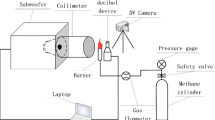Abstract
This experimental study scrutinizes the structural variation of a premixed propane-air flame according to the frequency change of ultrasonic standing waves (USWs) at various equivalence ratios. Visualization technique via Schlieren photography is employed in the observation of the flame structure and in the analysis of the flame velocities along the propagation. A distorted flame front and horizontal splitting in the burnt zone result from the USW. The vertical locations of the distortion and horizontal stripes are closely dependent on the frequency of the USW. In addition, the propagation velocity of the flame front floored by the standing wave is greater than that in the case without the excitation by the standing wave. As expected, the influence of the USW on the premixed-flame propagation becomes prominent as the frequency increases. The results suggest that a well-defined USW may be applied to combustion devices, such as gas turbines and chemical rocket engines, to achieve an active control of the instability that frequently intervenes in such systems.
Similar content being viewed by others
References
O. C. Ellis and C. De, Flame movement in gaseous explosive mixtures (Part 7), Fuel in Science and Practice 7 (1928) 502–508.
H. Guénoche and G. H. Markstein, Nonsteady flame propagation, Pergamon Press, New York, USA (1964) 107–176.
C. Clanet and G. Searby, On the ‘tulip flame’ phenomenon, Combustion and Flame, 105 (1) (1996) 225–238.
D. Dunn-Rankin and R. F. Sawyer, Tulip flames: change in shape of premixed flames propagating in closed tubes, Experiment in Fluids, 24 (2) (1998) 130–140.
A. K. Kaltayev, U. R. Riedel and J. Warnatz, The hydrodynamic structure of a methane-air tulip flame, Combustion Science and Technology, 158 (1) (2000) 53–69.
M. Gonzalez, Acoustic instability of a premixed flame propagating in a tube, Combustion and Flame, 107 (3) (1996) 245–259.
V. V. Bychkov and M. A. Liberman, Dynamics and stability of premixed flames, Physics Reports, 325 (4) (2000) 115–237.
S. Kadowaki and T. Hasegawa, Numerical simulation of dynamics of premixed flames: flame instability and vortex-flame interaction, Progress in Energy and Combustion Science, 31 (3) (2005) 193–241.
P. Pelce and P. Clavin, Influence of hydrodynamics and diffusion upon the stability limits of laminar premixed flames, Journal of Fluid Mechanics, 124 (1982) 219–237.
K. O. Sabdenov, Diffusion-thermal instability of a laminar flame, Journal of Engineering Physics and Thermophysics, 75 (4) (2002) 859–867.
A. M. Annaswamy and A. F. Ghoniem, Active control of combustion instability: theory and practice, Control Systems, IEEE, 22 (6) (2002) 37–54.
A. K. Hayashi, H. Sato, T. Endo, Y. Yasunami, S. Yoshimi, S. Ogawa, M. Ikame, T. Kishi, K. Hiraoka, K. Harumi and H. Oka, Analysis of unstable phenomena in premixed flame burners and their active control, Proceedings of 4th Symposium on Smart Control of Turbulence (2003) 173–182.
M. Shinoda, E. Yamada, T. Kajimoto, H. Yamashita and K. Kitagawa, Mechanism of magnetic field effect on OH density distribution in a methane-air premixed jet flame, Proceedings of the Combustion Institute, 30 (1) (2005), 277–284.
S. H. Won, S. K. Ryu, M. K. Kim, M. S. Cha and S. H. Chung, Effect of electric fields on the propagation speed of tribrachial flames in coflow jets, Combustion and Flame, 152 (4) (2008) 496–506.
J. S. Kim, H. S. Seo and S. S. Lee, An evolution of the premixed flame precipitated by ultrasonic standing wave, 48th AIAA/ASME/SAE/ASEE Joint Propulsion Conference & Exhibit, AIAA 2012-4032 (2012) 3437–3443.
M. Tanabe, T. Kuwahara, K. Satoh, T. Fujimori, J. Sato and M. Kono, Droplet combustion in standing sound waves, Proceedings of Combustion Institute, 30 (2) (2005) 1957–1964.
S. Dattarajan, A. Lutomirski, R. Lobbia, O. I. Smith and A. R. Karagozian, Acoustic excitation of droplet combustion in microgravity and normal gravity, Combustion and Flame, 144 (1) 299–317.
M. Saito, M. Hoshikawa and M. Sato, Enhancement of evaporation/combustion rate coefficient of a single fuel droplet by acoustic oscillation, Fuel, 75 (6) (1996) 669–674.
Author information
Authors and Affiliations
Corresponding author
Additional information
This paper was presented at the AJCPP-2014, Jeju Grand Hotel, Jeju, Korea, March 5–8, 2014. Recommended by Guest Editor Heuy Dong Kim
Sang Shin Lee received his B.S. and M.S. degrees in mechanical engineering from Pukyong National University in 2012 and 2014, respectively. After graduation, he joined the Operational Excellence Team of SK E&S in Korea.
Jeong Soo Kim received his M.S. and Ph.D. degrees from the Aerospace Engineering of KAIST in 1987 and 1992, respectively. By 2004, he had worked for the Agency for Defense Development and the Korea Aerospace Research Institute (KARI) as a principal researcher. While working for KARI, he participated in the development of KOMPSAT-1 at TRW (USA) from 1996 to 1998 as an assistant program manager of KARI-TRW’s co-development team. He also led his propulsion team toward the successful localization of the KOMPSAT-2 propulsion system. He is currently a faculty member of the Mechanical Engineering Department of Pukyong National University, Korea. His area of expertise and his research interests lie in the design and development of small propulsion engines and the study of the combustion phenomena of liquid propellants.
Rights and permissions
About this article
Cite this article
Lee, S.S., Kim, J.S. & Kim, H.D. An experimental study on the structural alteration of C3H8-air premixed flame affected by ultrasonic standing waves of various frequencies. J Mech Sci Technol 29, 917–922 (2015). https://doi.org/10.1007/s12206-015-0205-z
Received:
Revised:
Accepted:
Published:
Issue Date:
DOI: https://doi.org/10.1007/s12206-015-0205-z



